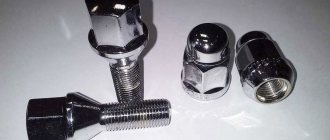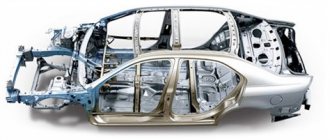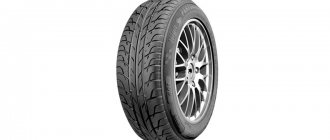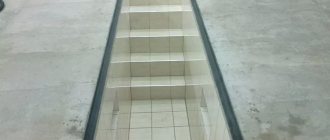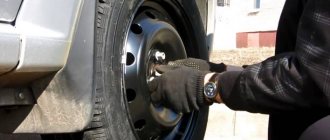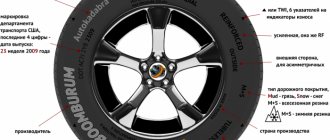Any car enthusiast sooner or later is faced with changing a tire on his car. This may be due to the change of season or when you missed a puncture on your car's tire unnoticed. We will tell you in detail and step by step how to change a tire on your car without any problems.
In any case, knowing how to change a tire on a car yourself will not hurt. After all, circumstances are different and sometimes there may simply not be anyone nearby who could help you in this matter.
If you are interested in information about or require winter tires, then see the details in the article: Choosing winter tires: what parameters must be taken into account . Through the “ Search ” line on the site. Also see additional information at: https://vsekolesa.ru/.
Park the car level and safe
You need to change the tire on a level area so that it is not on a slope. Otherwise, the car may roll away. Put the car on the handbrake.
If you have a manual transmission, then put it in speed. If automatic, then in Parking.
Place a stop under the wheel opposite the one you will be changing. This can be stone, brick or special triangular shaped stops. This fixation will help the car stay in place.
If changing tires on a car will take place on the roadway, you need to turn on the hazard warning lights and install an emergency sign.
The main thing about secret bolts
The purpose of the secret bolt is to protect the wheels from theft. The fastening unit has a head for a special key. Only the owner of the car will have the key to the bolts. Locks are popular among car enthusiasts, and many auto repair shops have similar or similar keys in stock, so it is recommended to select less common models.
Advantage and difference from conventional fastening bolts
The advantages and differences from traditional bolts are as follows:
- The bolt head is positioned low.
- The elements are protected by special rings.
- The wheel security bolts are made from high quality raw materials.
Varieties
Certain design differences should be taken into account when choosing secrets:
- The products have an outer head in the shape of an asterisk or polyhedron. The models are very popular among consumers.
- A bolt with an internally shaped head in the form of stars or special shapes. The downside of such secrets is their tendency to accumulate dirt.
- An element with one or more protective rings.
- Bolts that have heads of non-standard sizes. The shape of the pattern can be internal or external.
- Secret wheel bolts with several holes in the head. The design features are that the holes are not located according to a strictly established system, but correspond to certain dimensions of the fastener head. It will be difficult to adapt and unscrew this type of hardware in case of loss of the secret key.
Lower the car from the jack and tighten the bolts
Remove the old wheel from under the car.
And start slowly lowering the car.
Leave a small gap before lowering the car completely.
Tighten the nuts in the same sequence as when hanging. Now you can completely lower the car and remove the jack. Put away the jack and put away your tools. Put the broken tire in the trunk, most likely it can be repaired.
Check the tire pressure level and pump it up if necessary. Remove any supports you may have placed under the wheels.
Reasons for self-loosening of bolts and how to avoid it
Home > Articles > Why did the wheel come loose?
Experienced drivers will probably remember from their driving lives cases when suddenly, out of the blue, a wheel came loose. Why does this happen and how can such a situation arise?
Of course, the vast majority of drivers immediately blame the tire fitters, who, in their opinion, did not tighten the wheels. However, this is not always the case and there can be quite a few reasons for spontaneous wheel turning. For example, how could a wheel tightened with a torque wrench with a torque regulated by the car manufacturer be unscrewed? Faulty key? No, the wrench has been checked and the tightening torque matches the reference torque head. But why, even in this case, do the wheels sometimes unscrew?
How to determine the direction of rotation of a Goodyear tire?
Before determining the direction of the tire, it is important to know that the Goodyear tire direction marking for an asymmetric pattern is indicated: LEFT - left; RIGHT - right; outside - external side, inside - internal. install tires on the car according to the pattern on the tread or arrow.
Interesting materials:
How long does the iPhone 7 plus battery last? How long does hair removal last in the bikini area? How long does a reprimand last in the army? How many Daesangs does BTS have? How many speakers does iPhone 7 have? How long do the USE exams 2020 last? How long does 2nd higher education last? How long does it take for cats to adapt to a new home? How long does submariners have autonomy? How long is day and night in Rasta?
Unscrewing the hub nut on a VAZ: “burn, hit and twist!”
Now let’s look at the methods that may be the only effective ones in your case, but that doesn’t make them any less radical, even barbaric.
Strong hammer blows
If you hit the hub, you hit the bearing! If you are going to make a replacement, then go ahead! If you value the bearing, avoid this method.
Warming up the hub nut with a burner. Not recommended!
Using the burner
The law of physics is guaranteed to work, and the body (read: hub nut) will expand. And this will make it much easier to remove the stubborn part. There is one “but”: not only this one part heats up, but also everything else in the area of the burner. For example, a bearing. And it’s better not to allow this. As a more gentle option, we can suggest using a soldering iron and... patience. You'll need it.
Jumping on a lever
A chisel will help you remove the hub nut.
The “method” is fraught with the danger of unexpectedly breaking off the edges of the nut, breaking the key, and so on. Just don't do it.
Take a chisel and make notches on the edges
An increase in diameter, of course, makes the hub nut unsuitable for further use, but it will be easy to unscrew it.
How to tighten the nuts?
To successfully unscrew a rusty nut, you first need to collect the tools that will help you in this matter: A spanner. Socket wrench. Heads with a collar.
Interesting materials:
Who invented the first manga? Who invented the first school uniform? Who invented the first emoticon? Who invented the first explanatory dictionary? Who invented shellac for nails? Who invented solfeggio? Who came up with prohibition in the Soviet Union? Who invented Marvel superheroes? Who coined the term meme? Who invented toilet paper?
What to do if the wheel bolt does not come off
Some car enthusiasts do not know what to do if the fasteners do not move. The first step is to put the vehicle on the handbrake and make sure that the vehicle is stationary. A stuck bolt can be unscrewed in the following ways:
- Leverage method. Due to the insufficient length of the wheel wrench handle, it is not possible to turn the bolt with the required force. It's easy and safe to use a wrench handle extension or a long-handled tool. Such a device will increase the strength of the mechanical influence. Experienced motorists recommend using a metal pipe to lengthen the handle.
- Use your leg strength. If you cannot unscrew the bolt by hand, you need to try pressing the tool with your foot. The handle of the wrench should be parallel to the surface of the ground. You will need to press the key with your foot and turn it counterclockwise. In extreme cases, you will need to stand on the key with both feet and hold on to the car body with your hands.
- Use a hammer or mallet. You will need to pick up both tools, place the mallet in the right place and hit it with a hammer. This option will help move the threads of a frozen nut. In extreme cases, a hammer can replace a stone. Avoid glancing impacts that damage the bolt and key. The blows must be accurate.
- Using a wrench with a dynamometer. If the wheel fasteners have been secured too tightly, it is recommended to use a tool with a dynamometer. Recommended force parameters are indicated in the device instructions.
- Use of chemical compounds. If the bolts are too tight, Liquid Wrench or PB Blaster should be used. Apply the product to the bolt using a watering can with a thin spout. After waiting 10 minutes, dismantling begins.
Design features of car wheel mounting bolts
Product parameters must correspond to the characteristics of a car wheel. The main parameters of bolts include:
- dimensions and direction of thread;
- turnkey size;
- strength class.
Cars
Nuts of types “A”, “B” and “C” are available with six types of small format threads. For M12 the thread pitch can be 1.25 mm, for M12, 14, 18, 20, 22 the thread pitch is 1.5 mm.
Freight
Class “D” nuts are intended for truck wheels. These are M18, 20, 22 hardware with a thread pitch of 1.5 millimeters. The thread direction can be right or left. The size of the wrenches for the nuts is 17, 19, 24, 27, 30 or 32.
Chemical
Now we will consider methods for those who do not rely on the help of physics, but want to solve the problem with the help of chemistry. Your laboratory should have: kerosene, white spirit, acidified sulfuric acid, zinc, plasticine, hammer, water, sandpaper, wrench, chisel.
Attributes of the chemical method for unscrewing the nut
We moisten the nut and bolt with kerosene (experienced people recommend making a mixture of White Spirit and kerosene), applying a swab to them, it doesn’t matter whether it’s cotton or gauze. After some time - from an hour to a day, and with repeated attempts, you may find that the hub nut can be easily unscrewed. But even here you cannot do without force: at a minimum, you will probably have to work with sandpaper to clean the parts from rust. If even after this things don’t work, you should help with a hammer: tap it on the edges of the hub nut.
If in this case you are not successful, make a small container out of plasticine, secure the hub nut on top, pour water with sulfuric acid into it, and put zinc in the container. A chemical reaction begins that does a very good job of removing rust. Usually a day is enough for even advanced corrosion to go away from a part. Finish the job with a wrench. But this method is valid only in the case when the reason is that the nut is tightly stuck and/or rusted, and if it was simply tightened, neglecting the required tightening torque (to “be sure”), then you just need to tighten it.
What is the result..
As you can see, unscrewing the hub nut is not an easy task, but it can be solved. Please note that the first step is to try to preserve the hub nut by using penetrating fluids such as Vedeshka. Physical efforts to twist the hub should be moderate. And, of course, you should refrain from strong blows and heating with a torch, as methods that can render not only the nut, but also the bearing unusable.
Source: etlib.ru
What you need to rotate your tires
In this case, you will need the same tools as when replacing a wheel: a jack, wheel and security keys, gloves. How to unscrew the nuts with wrenches was described earlier in the article.
Wheel rotation schemes
The correct layout will help make wheel rotation safe. If the scheme is incorrect, the car will be pulled to the side. You need to understand which car is front-wheel drive, rear-wheel drive or all-wheel drive, since each has its own scheme. When rearranging, the experts recommend marking the tires so that the robots do not confuse anything during the process. You also need to remember that the front wheels wear out faster than the rear ones, because the front of the car takes up about 60% of the total weight. Rotation according to the instructions must be done every 10 thousand kilometers.
For front wheel drive vehicles with non-directional pattern
- In front wheel drive cars with a non-directional design, there are two ways to do the rotation:
- crossed: the front right wheel will exchange with the rear left, and the front left will exchange with the rear right;
- cross-shaped in the direction of the front axle: the front wheels go back on their sides, and the rear wheels go to the front, but on other sides (right rear to front right, front right to rear right).
For rear-wheel drive and all-wheel drive vehicles
If the car is rear-wheel drive or all-wheel drive with a non-directional pattern, then:
- the front and rear wheels are rearranged diagonally;
- cross-shaped towards the tail axle: the rear tires are placed forward on their sides, and the front tires are placed back on the other sides.
In cases of all-wheel drive vehicles with non-directional wheels, the cross method is used. With a directional tread design, you need to move the front tires to the rear tires on one side.
The second way is chemistry
If brute force does not help, then you will have to use special tools to help unscrew something that does not want to unscrew. The surest remedy is WD-40 lubricant, which probably every car enthusiast has. It is necessary to generously fill our stubborn bolt with this lubricant and wait a few minutes for the “Vedashka” to penetrate the thread. If there is no lubricant in the car, you can take some from the brake fluid barrel. Next, you need to forcefully pull the key in one direction or the other, as if rocking the bolt. This will destroy the rust layer in the thread. If he continues to resist, then we take the stone again and move on to the first method.
Required Tools
In order to begin work on changing a tire, you first need to mark the tool, because it will not be possible to do this with your “bare” hands. Useful for repairs:
- the wheel that will be installed,
- jack,
- a wheel wrench that matches the parameters of the wheel nuts,
- It's better to have gloves.
In some cases (depending on the car brand) you will need:
- adjusting pins,
- The secret key
- socket wrench with replaceable heads.
An aerosol, which the driver calls a “vedeshka,” will also be useful.
It is better to use wrenches with a long handle; they allow you to apply more effort and remove heavily dirty and rusty nuts.
Jack up the car
Proceed to lift the car step by step. At this stage it is very important to install the jack correctly. Otherwise, you can scratch the car's paintwork and damage the sills.
There are special reinforced places on the bottom where you can place emphasis. They are located immediately behind the front wheel or in front of the rear.
How to install the jack correctly is in the instructions for the car. They are designated as cutouts, triangles at the bottom of the threshold.
If there is a plastic pad in place of the weld, there will be a gap to secure the jack. Place a jack under the bottom of the car. Turn the handle clockwise.
The jack must rise straight and not tilt.
Correct installation of the jack, diagram:
If you notice that the jack is falling through, it means the soil underneath is not firm enough.
To fix this, place a piece of board under it, something durable.
You should not raise the wheel high; the distance should be approximately 5-10 cm from the ground.
